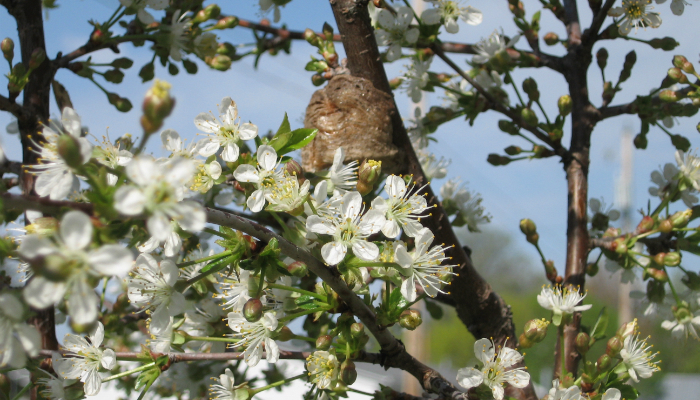The praying mantis—not all good, but not all bad

One of the signs of spring that can easily be overlooked is a globular formation attached to a twig in a tree or on a shrub. At first glance, it might resemble a dried leaf that has curled or a canker of some sort with a circumference roughly equal to that of a quarter. Most likely it’s the egg case of a praying mantis.
We had only started noticing praying mantises in our yard a couple of years ago, and we had never seen the egg cases or ootheca. The discovery of two egg cases this spring led me to learn more about this insect. I had heard they are beneficial because they eat, among other thing, aphids. They do eat aphids and other soft-bodied insects when young but then move on to larger insects.
Because they hold their front legs in a praying position and because they perch patiently on bushes and plants waiting for food, they have been invested with spiritual meaning by some cultures. Their other behaviors, however, give a different impression.
The mating process happens in the fall. After they mate, the female devours the male although sometimes she does this during mating. She then attaches the egg case to a leaf or twig where it remains over the winter. In spring, about mid-May, the young hatch. More than 100 nymphs may emerge. Nymphs do not go through a metamorphic stage but resemble the adult when they hatch. As they dry out, they will disperse, but if there is not enough to eat, the young will begin to consume each other.
Mantises lie in wait for prey to come their way, then, with great speed, they ambush the unsuspecting insect. They are not particular in their tastes and, among other things, eat grasshoppers, crickets, earwigs, and tomato worms as well as beneficial insects such as lady bugs and various pollinators.
With their triangular heads, which can swivel 180 degrees, compound eyes that enable them to detect movement with precision, and their front legs perfectly built for swiftly snatching prey, mantises are almost alien in their appearance. They are not warm and fuzzy yet neither all good nor all bad. Opportunistic and pragmatic, they are fascinating examples of nature’s unique engineering.
I think that’s a pretty big story to come out of a homely little ootheca! Now that the days are warm, I’m checking regularly to see if those hundreds of hatchlings have burst into the world. It pays to look at the small things in the great outdoors.


